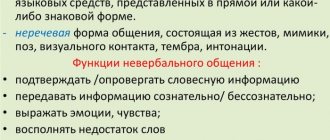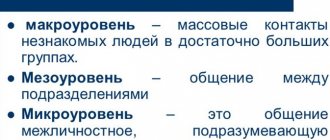The mechanism of human communication includes far more than just speech and writing. Since ancient times, people have resorted to alternative ways to express their thoughts or show their attitude towards something. Such non-verbal means of contact as gestures, facial expressions and pantomime can also serve as indicators of the interlocutor’s reaction or speak about his emotional state.
According to psychologists and science specialists who study human communication, more than half of the content of information exchange is transmitted non-verbally.
Basic definitions
Interesting. Psychologists have come to the conclusion that facial expressions, gestures, postures and intonations not only allow you to better understand the essence of what is being said, but also help form a general impression of your communication partner.
Gestures and facial expressions are an independent section in psychology. Its main concepts are:
- Facial expressions in psychology are the expression of an emotional state through a smile, raising eyebrows, squinting eyes, clenching the jaw.
- Gestures in the psychology of communication are body movements with the hands, head, and whole body. In some cases, gestures can replace words.
- Pose is a certain position of the body in space, which an individual chooses depending on his comfort, conversation situation, and emotional state.
- Physiognomy is the ability to recognize the individual characteristics of an interlocutor by his facial features, gestures, and facial expressions. Specialists are able to determine by facial expression not only the psychological characteristics of a person, but also his state of health.
Important! Facial expressions and gestures play an important role in interpersonal relationships. While men and women can partially control their gestures, this is not yet available to a child, which is why babies do not know how to deceive.
Non-verbal communication. Truth or myth?
Some doubt the existence of body language, considering all conversations on this topic to be empty fiction.
Opponents of the theory of postures and gestures argue that changes in body position occur for completely different reasons. For example, when sitting, it is more convenient for a person to cross his arms if there are no armrests, and not at all because he is a misanthrope.
People start yawning not only because they start to get bored. Lack of oxygen in a cramped office or overwork can trigger this process. Therefore, before formulating conclusions, it is necessary to understand why the interlocutor began to actively gesticulate or rotate an object in his hands.
An experiment will help reveal sign language. And the subjects can be friends and relatives, whose facial expressions, postures and gestures change in different life situations. But in no case should you impose and put pressure, otherwise you can damage many years of friendship and good relationships.
Psychology of facial expressions and gestures, types and meaning
Low self-esteem in a person from a psychological point of view
Facial expressions, psychology of gestures have many descriptions of what they mean. The position of the body and hands in space during communication, the characteristics of handshakes, head movements and facial expressions are frequently used emotional gestures and people observe them in the process of interpersonal communication every day.
Torso bends
Attention! In interpersonal communication, body tilt is always a bodily reaction to a signal from the brain. This is how the brain gives an impulse about the need to protect itself. Therefore, such reactions cannot be feigned.
Standing torso position
If people communicate while standing, then you can notice multiple changes in the position of the interlocutors’ torso. When a person sits with his elbows on the back of a chair or armchair, his body does not send as many nonverbal signals.
If the person you are talking to is genuinely interested in what you are saying, he will lean forward from time to time, fearing that he will miss something important. When a person talks about his successes, he involuntarily straightens his shoulders and his torso bends forward.
Proud of myself
When in a large company, a person unconsciously tilts his torso towards the one he likes most. If he finds himself in an unfamiliar company or feels a cool attitude towards himself from the majority of those present, his torso will shrink (he will pull his head into his shoulders, slouch) - he wants to become smaller, more inconspicuous. This is how the body tries to protect itself from potential threats.
Hand position
If a person crosses his arms over his chest, this indicates his need to conserve his energy. This pose will be called closed. Psychological science says that when a person finds himself in an unfamiliar place, he feels uncomfortable, so he wraps his arms around his shoulders. In addition, crossing your arms over your chest is a sign of a negative attitude towards your interlocutor or doubt.
Attention! Using this gesture may be a sign of deception. If an adult is deceiving, the pattern of using this gesture may be erased: rubbing the wrist, pressing a book to the chest.
The sight of clasped fingers indicates hostility or disappointment. Moreover, the degree of severity of negative feelings is directly related to how high the clasped hands are located. In addition, if a person has something to hide, then during communication he may keep his hands deep in his pockets.
When a person is worried about something, trying to restrain the storm of feelings that overcomes him, he clasps the forearm or wrist of the other hand behind his back with one hand. By hiding his hands, the individual tries to hide stress.
Head Gestures
A mimic nod of the head is regarded as an alternative to a positive answer. Shaking your head means disagreement and a negative response.
Attention! The verbal response may not correspond to the head movements. If a person agrees with the interlocutor, but at the same time shakes his head from side to side, you need to believe not the words, but the non-verbal language.
Facial expression
Facial expressions, psychology of emotions, and mood are closely interrelated. Observing changes in facial expression during a conversation allows you to understand how your partner feels about the conversation.
Additional Information. A person can hold back laughter or tears, that is, hide joy or resentment or disappointment from others. But people cannot control the movements of their eyebrows, so they cannot hide surprise, fear or anger.
Fear
Handshakes
In Russia, a handshake is used as a greeting when meeting, and as a farewell when finishing communication. This gesture is also used in the official business sphere when congratulating someone on a particular professional achievement.
The owner of a strong will has a strong handshake; for this action he holds his hand palm down. Unconfident people use a limp handshake, giving their hand palm up. A weak handshake indicates that the interlocutor is trying to keep distance in the relationship.
How does the behavior of a lying person manifest itself?
- Often, after telling a lie, the following gestures are observed - loosening a tie, touching the neck, nose, covering the mouth. They often hide their hands during a conversation and may fidget or sway, which indicates anxiety. The opposite behavior also happens - they stand motionless, as if petrified, without showing emotions. They gesture a little, because the brain is busy inventing and controlling the telling of the story.
- Position of the legs - they can swing their legs, showing nervousness, impatience, often the legs are facing in the other direction from the interlocutor. They can make sudden movements with their shoulders, touch the interlocutor, trying to “earn their way into trust.”
- Facial expressions - they hide their gaze, look in the other direction, have a darting gaze, or vice versa do not avert their gaze, look straight at them. The smile is usually strained, unnatural, only movement of the lips, and no changes are visible in the corners of the eyes. Frequent blinking also expresses nervousness or a desire to hide information or feelings.
- Speech - usually spoken in a calm tone, giving meaning to words. They may raise their tone when they are bragging or in an excited state. Usually, a change in the tone of speech does not happen by accident; watch the tone and words. They may stammer, “moo,” make other sounds, and lose their thoughts.
Personal space, communication areas
What kind of mood does a person have - types in psychology
To feel comfortable and free to use gestures, you need personal space. All people react differently to invasion of personal space. Anxious people tend to maintain a greater distance in communication. Confident individuals are less concerned about protecting their personal space. Aggressive people constantly try to expand their personal zone: their gestures are sweeping, and their poses are such as to take up as much space as possible.
Psychologists have calculated optimal zones for different types of interpersonal communication:
- An intimate area that involves physical contact. Its distance is from 15 to 45 cm. Only the closest people are at this distance.
- The personal zone is 75-120 cm. It is used in everyday communication with friends.
- Social zone – from 120 to 360 cm. At this level, official business communication is carried out.
- The public area is needed for lectures. Its level is 3.5-7.5 m.
Rules of interpretation
There are general rules for “reading” body language:
- it is necessary to take into account the person’s age, profession, position and social status: for example, a child has few gestures, but more facial expressions, while an adult has highly developed gestures;
- abundant gestures or their absence does not always mean that a person is too emotional or, conversely, cold. Highly educated people with large vocabularies do not need excessive gestures to express themselves;
- lack of synchrony between speech and non-verbal language indicates unreliable information.
These are the basic rules. They must be known and observed when “reading” the opponent’s personality.
How to recognize truth and lies from a person
Purple color in human psychology - what does it mean who likes it?
It is quite simple to recognize a person’s sincerity or deception by facial expressions and gestures:
- When people tell the truth, they look the other person in the eyes, their palms are open and visible. The person turns his whole body towards the interlocutor, the soles of his feet are also directed towards the communication partner. The pace of his speech is calm and even.
- If a person is deceiving, he will avoid eye contact. During the conversation, he will turn away from the interlocutor, touch his face (adjust his glasses, touch his nose, cover his mouth with his hand). His speech will be confused.
Interesting. When little children lie, they cover their mouths with their hands because they know that lying is wrong. Adults have great control over their body, so the desire to stop the flow of false speeches manifests itself in an erased form: touching various parts of the face.
Deceives
Look and eyes
His eyes openly speak about a person’s inner experiences - it’s not for nothing that experienced “players” try to hide their expression behind the glasses of dark glasses.
People are usually extradited:
- any changes in the usual expression of the eyes - the emergence of a certain emotion, a signal of response to a stimulus;
- involuntary eye movements, noticeably “shifty eyes” - anxiety, shame, deception, fear, neurasthenia;
- a brilliant look - fever, excitement;
- glassy look - extreme weakness;
- enlarged pupils - a feeling of interest and pleasure from information, communication, photography, a partner, food, music and other external factors, acceptance of something, but also severe suffering;
- constriction of the pupils - a surge of irritation, anger, hatred, initial negative emotions, rejection of something;
- chaotic movements of the pupils are a sign of intoxication (the more such movements, the drunker the person);
- increased blinking - excitement, deception.
People always prefer to look at those they clearly admire, or those with whom they have close relationships, from a close distance;
Women show more visual interest than men. During communication, they most often look into the partner’s eyes when they listen, and not when they speak, although, when carrying out suggestion, they sometimes use direct gaze into the eyes at the moment of speaking the dialogue.
A person who looks you in the eye for noticeably less than one third of the entire communication period is either dishonest or trying to hide something; the one who openly persistently peers into your eyes, experiences increased interest in you (pupils are dilated), shows outright hostility (pupils are constricted) or strives to dominate.
Modifications of eye contacts have the following meaning:
- absent look - concentrated thinking;
- shifting your gaze to surrounding objects and to the ceiling - loss of interest in the conversation, an excessively long monologue of the partner;
- persistent and intent gaze into the eyes (pupils constricted) is a sign of hostility and a clear desire to dominate;
- persistent and intent gaze into the eyes (pupils dilated) is a sign of sexual interest;
- looking away and lowering your gaze - shame, deception;
- side view - distrust;
- the gaze then looks away, then comes back - lack of agreement, distrust.
Features of foreign language of facial expressions and gestures
Abroad, the language of facial expressions and gestures, understandable to the residents of Russia, is transformed and modified. When planning a trip to a particular country, you must definitely study the meaning of non-verbal signals in this country, since the same gestures in different countries can be interpreted differently.
For example, hugging and kissing when meeting in England is regarded as vulgar behavior. By tapping his finger on his nose, the Englishman emphasizes that his words are secret information. A clenched fist with the index finger raised is considered an offensive gesture in England.
If in Holland a person twirls his finger at his temple during a conversation, he emphasizes the wit of his interlocutor. Rubbing the back of his nose, the Dutchman talks about greed.
The French express their admiration for something by blowing a kiss. If a Frenchman pulls his lower eyelid down with his index finger, he expresses doubt in the words of his interlocutor. In France, distrust of a person is expressed by rubbing the bridge of the nose.
Thus, in the psychology of communication, human facial expressions and gestures play an important role. They make communication interesting and help distinguish truth from lies. Knowledge of the facial expressions and gestures of other countries will help you avoid awkward situations when communicating with foreigners.
Communication with foreigners
The importance of sensorimotor signals
The ability to correctly interpret nonverbal signals is of great importance in modern human life. After all, it is precisely such gestures that most fully express human feelings and experiences. In some cases, emotional experiences can be so strong that without verbal signals it is almost impossible to convey the whole gamut of overwhelming emotions. In addition, these gestures allow you to establish deeper communication contact between interlocutors.
Often, such knowledge allows one to achieve certain results in entrepreneurial activity. The main feature of nonverbal signals is that a person cannot control them. Examples of using such means of communication allow you to learn to detect false notes in the words of your interlocutor and avoid attempts to manipulate your behavior.
A person who knows the basics of nonverbal communication better understands the interlocutor, which allows him to distinguish lies from the truth.
Gestures warning of aggression
It is important to recognize gestures of aggression and threats in a timely manner - this makes it possible to prevent a conflict in time and get away from the direct line of attack of the interlocutor. An aggressive attitude manifests itself:
- Clenching your fists. The interlocutor speaks in a calm tone, his posture is relaxed, but his hands are constantly clenched into fists - a clear signal of pent-up anger.
- Fists resting on the surface of the table, hips or pressed to the waist - a direct threat, readiness to attack.
- Hands hidden behind back. The person is literally trying to control himself and not show aggression.
- Pursed lips, tightly clenched jaws. They express contempt and dissatisfaction with the interlocutor.
- Scratching the back of the neck and the back of the head. Anticipation of attack, demonstration of readiness for defense.
If during a conversation a person twitches his upper lip, flares his nostrils, squints his eyes, he is ready for open confrontation, demonstrates superiority over his opponent, and threatens.









